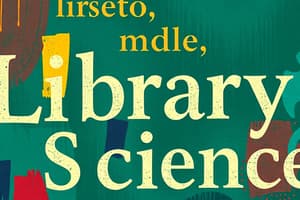Podcast
Questions and Answers
What are the three main functions of bibliographic control tools?
What are the three main functions of bibliographic control tools?
The three main functions of bibliographic control tools are identifying or finding a particular bibliographic item, collocating or gathering closely related materials, and evaluating or selecting the most suitable item.
What is the main name of an item, including any alternative title but excluding parallel titles and other title information?
What is the main name of an item, including any alternative title but excluding parallel titles and other title information?
The title proper
What is the term for the title proper in another language?
What is the term for the title proper in another language?
Parallel title
What is the abbreviation for "General Material Designation"?
What is the abbreviation for "General Material Designation"?
The title proper should always be transcribed exactly as it is found in the chief source of information.
The title proper should always be transcribed exactly as it is found in the chief source of information.
What is the purpose of "Statement of Responsibility" in bibliographic description?
What is the purpose of "Statement of Responsibility" in bibliographic description?
If the title proper consists solely of the name of the person or body responsible for the bibliographic resource, that name should be repeated in the statement of responsibility.
If the title proper consists solely of the name of the person or body responsible for the bibliographic resource, that name should be repeated in the statement of responsibility.
What is the purpose of "General Material Designation" (GMD) in bibliographic description?
What is the purpose of "General Material Designation" (GMD) in bibliographic description?
What is the purpose of "Parallel Title" in bibliographic description?
What is the purpose of "Parallel Title" in bibliographic description?
When there is more than one subtitle, they should be recorded in chronological order in the bibliographic description.
When there is more than one subtitle, they should be recorded in chronological order in the bibliographic description.
Name the three levels of description offered by AAC2Rr.
Name the three levels of description offered by AAC2Rr.
The first level of description is usually adopted by large libraries with specialized collections.
The first level of description is usually adopted by large libraries with specialized collections.
The second level of descriptor is usually adopted by libraries with a varied collection.
The second level of descriptor is usually adopted by libraries with a varied collection.
The third level of description is used by national bibliographic agencies.
The third level of description is used by national bibliographic agencies.
Match the following bibliographic areas with their corresponding sources of information:
Match the following bibliographic areas with their corresponding sources of information:
The title proper is a translation of the title in another language.
The title proper is a translation of the title in another language.
What is the punctuation used for the parallel title in bibliographic description?
What is the punctuation used for the parallel title in bibliographic description?
The statement of responsibility is a statement transcribed from the item that identifies the person or entity responsible for the intellectual or artistic content of the item.
The statement of responsibility is a statement transcribed from the item that identifies the person or entity responsible for the intellectual or artistic content of the item.
When the chief source of information includes a date that varies from issue to issue, this date should be omitted in the bibliographic description.
When the chief source of information includes a date that varies from issue to issue, this date should be omitted in the bibliographic description.
If there is a conflict between where the title appears in the chief source of information and where the statement of responsibility appears, the order in which the statement appears is more important.
If there is a conflict between where the title appears in the chief source of information and where the statement of responsibility appears, the order in which the statement appears is more important.
If a single statement of responsibility names more than three persons, they should all be included in the bibliographic description.
If a single statement of responsibility names more than three persons, they should all be included in the bibliographic description.
Titles such as 'Dr.' or 'Prof.' should always be included when referring to an author in a statement of responsibility.
Titles such as 'Dr.' or 'Prof.' should always be included when referring to an author in a statement of responsibility.
Flashcards
Bibliographic Control
Bibliographic Control
The practice of organizing library materials for easy access and retrieval using standardized rules and procedures.
Bibliographic Description
Bibliographic Description
Detailed information about a library item, including author, title, publication details, and physical description.
Bibliographic Record
Bibliographic Record
A structured record containing all the bibliographic information about a library item.
Bibliographic Tools
Bibliographic Tools
Signup and view all the flashcards
Library Catalog
Library Catalog
Signup and view all the flashcards
Title Proper
Title Proper
Signup and view all the flashcards
Alternative Title
Alternative Title
Signup and view all the flashcards
Parallel Title
Parallel Title
Signup and view all the flashcards
Running Title
Running Title
Signup and view all the flashcards
Statement of Responsibility
Statement of Responsibility
Signup and view all the flashcards
Chief Source of Information
Chief Source of Information
Signup and view all the flashcards
Main language
Main language
Signup and view all the flashcards
General Material Designation (GMD)
General Material Designation (GMD)
Signup and view all the flashcards
Rule 1B. Title Proper
Rule 1B. Title Proper
Signup and view all the flashcards
Rule 1B. Title Proper
Rule 1B. Title Proper
Signup and view all the flashcards
Rule 1B. Title Proper
Rule 1B. Title Proper
Signup and view all the flashcards
Rule 1B. Title Proper
Rule 1B. Title Proper
Signup and view all the flashcards
Rule 1B. Title Proper
Rule 1B. Title Proper
Signup and view all the flashcards
Rule 1B. Title Proper
Rule 1B. Title Proper
Signup and view all the flashcards
Rule 1C. General Material Designation (GMD)
Rule 1C. General Material Designation (GMD)
Signup and view all the flashcards
Rule 1D. Parallel Title
Rule 1D. Parallel Title
Signup and view all the flashcards
Rule 1D. Parallel Title
Rule 1D. Parallel Title
Signup and view all the flashcards
Rule 1D. Parallel Title
Rule 1D. Parallel Title
Signup and view all the flashcards
Statement of Responsibility
Statement of Responsibility
Signup and view all the flashcards
Rule 1F. Statement of Responsibility
Rule 1F. Statement of Responsibility
Signup and view all the flashcards
Rule 1F. Statement of Responsibility
Rule 1F. Statement of Responsibility
Signup and view all the flashcards
Rule 1F. Statement of Responsibility
Rule 1F. Statement of Responsibility
Signup and view all the flashcards
Rule 1F. Statement of Responsibility
Rule 1F. Statement of Responsibility
Signup and view all the flashcards
Rule 1F. Statement of Responsibility
Rule 1F. Statement of Responsibility
Signup and view all the flashcards
Study Notes
Module 2, Lesson 2: Bibliographic Principles, Control, and Elements: Overview and Area 1
- Objectives:
- Assess bibliographic standards used in cataloging and classifying library materials.
- Validate bibliographic information from library materials by determining its source of information.
Activity
- Activity: How helpful is the bibliographic record to you?
Functions of Bibliographic Descriptions
- Bibliographic control tools have three main functions:
- Collocation: Grouping related terms and materials together. An example is grouping all materials about dinosaurs together.
- Identification: Finding a specific item. Using a library catalog to find a book about botany.
- Evaluation: Selecting the best materials to meet a user's needs. Choosing the right book for the reader. This reflects Ranganathan's law: "Every book, its reader". Library materials must be provided that meet the specific need of the user.
Question
- How to collocate Huckleberry Finn and The Adventures of Huckleberry Finn?
- Use authority control to group related materials together. Records should be grouped under one specific authority control if they relate to the same material, such as Huckleberry Finn.
Levels of Description
- AAC2R offers three levels of description:
- Level 1: Minimum level with fewer elements, usually employed by small libraries with basic collections and simple users.
- Level 2: Fuller description, adopted by medium-sized libraries with varied collections.
- Level 3: Comprehensive description, usually employed by national bibliographic agencies.
Areas and Elements of Bibliographic Description
- Prescribed Areas:
- Area 1: Title proper; parallel title or statement of responsibility.
- Area 2: Edition information
- Area 3: Special area for serials, maps, music
- Area 4: Publication area
- Area 5: Physical description
- Area 6: Series information
- Area 7: Notes area
- Area 8: Standard number
Area 1: Title and Statement of Responsibility
- Title Proper: The main name of an item (excluding alternative titles, but including subtitles). Parallel titles translate to different languages. Running title repeats the title on every page.
- Statement of Responsibility: Attributes authorship of content. Include the name of a person, publisher or corporate body responsible for a work and its content. The term "et al." implies multiple authors and is used when there are more than three and the name need not be listed. The statement should be presented after the title information. Often, titles and statements of responsibility are transcribed without their original punctuation marks and capitalization.
- General Material Designation (GMD): Describes the type of material (e.g., motion picture, sound recording, etc.) placed in square brackets immediately after the title. Note: Use brackets around any extra text you have added to the title.
- Parallel Title: The translation of a title in another language or subtitle. Appear together, but with a
=separating the primary title and translation.
Studying That Suits You
Use AI to generate personalized quizzes and flashcards to suit your learning preferences.




